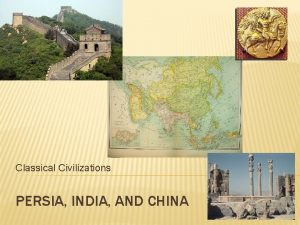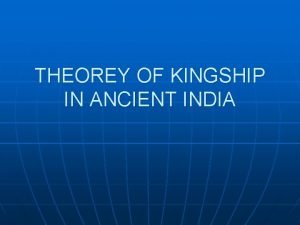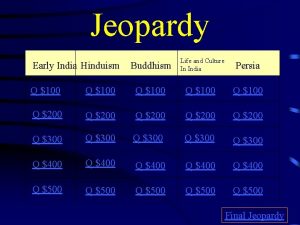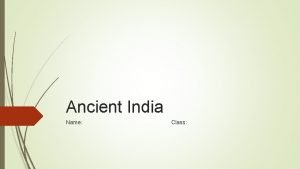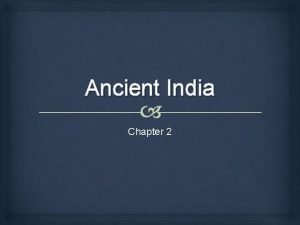Music of Ancient India Music in ancient India






- Slides: 6

Music of Ancient India

Music in ancient India, encompassing the modern-day Indian subcontinent of India, Pakistan, and Bangladesh, can be reproduced from written works dating to the Indian Classical period.

Surviving music -The Samaveda, one of the ancient core Hindu scriptures known as the Vedas, consists of a collection ( or samhita) of hymns, portions of hymns and detached verses. - which are the oldest scriptures in the. Hindu tradition dating back to 1500 BCE. -They were intended to be sung using melodies called Samagana whose musical forms are indicated. -These hymns were sung by priests at sacrifices in which the juice of the Soma plant, clarified and mixed with milk and other ingredients, were offered to drink to various deities. The brain while listening to Samaveda: https: //www. youtube. com/watch? v=DX 11 b. Bpu Kl. U

Types of Music -Indian classical music is both elaborate and expressive -Unlike modern Western classical music, Indian classical music places great emphasis on improvisation. -Indian classical music is monophonic (based on a single melody line) in nature, which is played over a fixed drone. -A raga is one of the melodic modes used in traditional South Asian music genres such as Indian classical music. -uses a series of five to nine musical notes upon which a melody is constructed -the way the notes are approached and the mood they convey in musical phrases are more important in defining a raga than the notes themselves. -ragas are associated with different times of the day, or with seasons Ragas and their seasons – What season do you think this picture would be associated with? What is a raga? Modern interpretation of it: https: //www. youtube. com/watch? v=Wgh. XM 8 s 4 jq. U

Carnatic vs. Hindstani Music -Carnatic music, from South India, tends to be more rhythmically intensive and structured than Hindustani music. An example of this is the use of fixed compositions similar to Western classical music. Primary themes include worship, descriptions of temples, philosophy, and nayaka-nayika (Sanskrit "hero-heroine") themes. -Hindustani music is mainly found in North India. Hindustani music has assimilated various folk tunes. There is an amount of foreign influences in Hindustani music in terms of the instruments, style of presentation, and ragas. Performances are usually marked by a considerable amount improvisation. *Carnatic music example: Hindustani music example: https: //www. youtube. com/watch? v=s 5 a 3 pth. L_t. U https: //www. youtube. com/watch? v=pb 5 iw. Si 5 OIo

Instruments -Instruments typically used in Carnatic music include: -veena, venu, gottuadyam, harmonium, mridangam, kanjira, ghatam, nadaswaram, violin -Instruments typically used in Hindustani music include: -sitar, sarod, surbahar, esraj, veena, bansuri, shehnai, sarangi, violin, santoor, pakhavaj, and table. That’s a bajillion instruments. Let’s go to this link to look at them: https: //en. wikipedia. org/wiki/Indian_classical_music#Instruments


